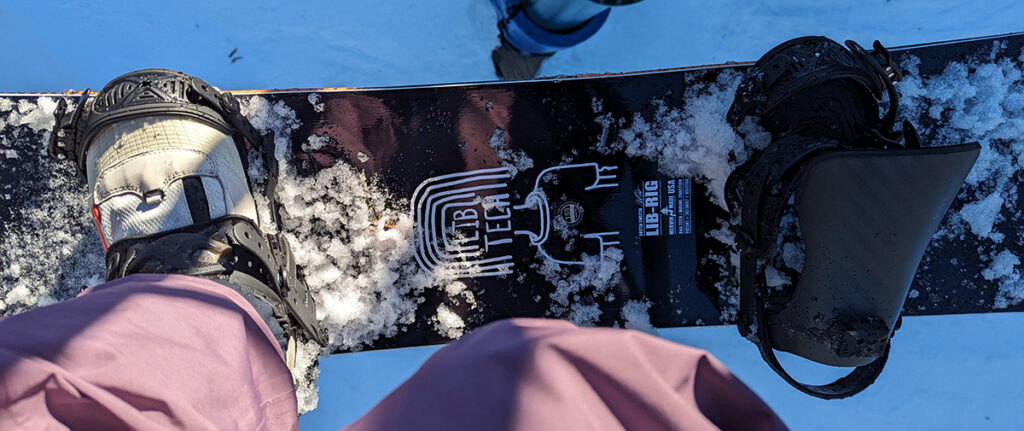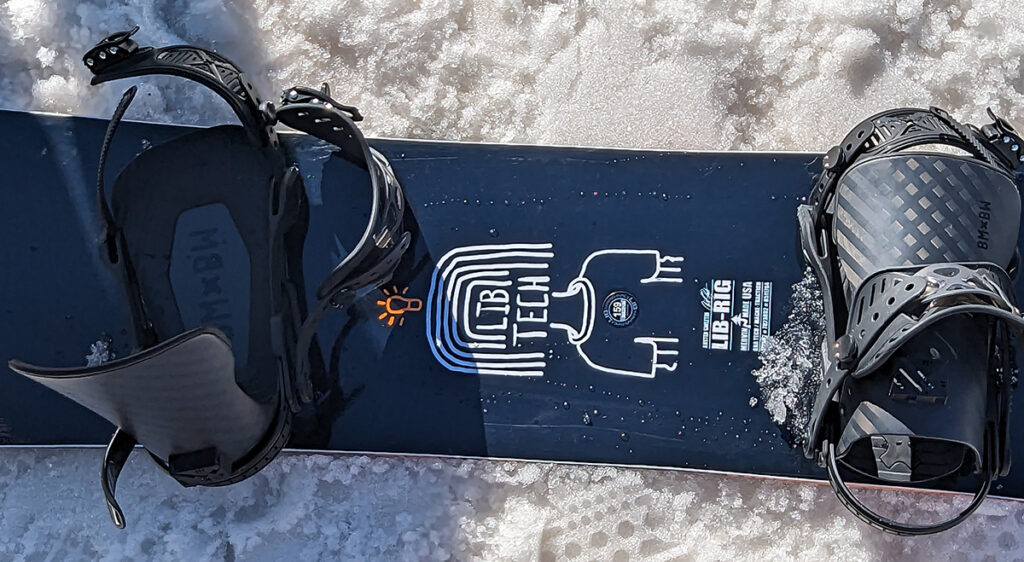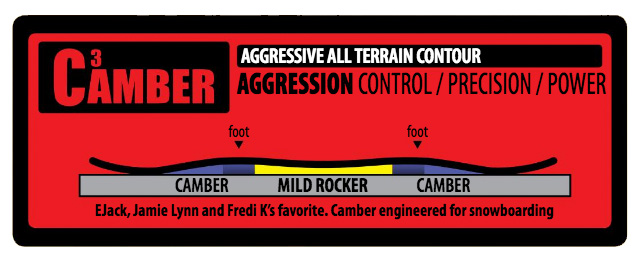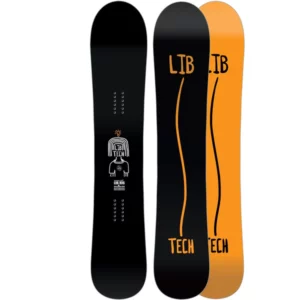The Lib Tech Lib Rig is a new board this season, which is made for Austen Sweetin. It’s a directional all mountain board, that has a C3 (camber) profile, and a little bit of taper.
How the 2024 Lib Tech Lib Rig rides

Board size: 159cm
Boots: Vans Infuse
Bindings: Bent Metal Solution
I weigh 70kg or 155lbs
This review is based on me riding the 159cm 2024 model, set up Bent Metal Solution bindings. These are some pretty stiff bindings, which I think suited this board pretty well.
I was riding this board at Mt Hotham, in Victoria, Australia. It was spring conditions, so quite firm snow in the morning, which stayed hard in the shade, while the rest turned into slush by the time it warmed up in the afternoon.
They aren’t bad conditions for testing a board out, because you get a good test for icy turns, as well as seeing how fast the board will ride in softer slushy snow, which can really slow a board down.

Camber Profile
The last board that I had ridden with a C3 profile was the old GNU Mullair, which I found to be a pretty serious, aggressive board.
In general I do favour camber boards overall, I like the stability, edge hold and the reliable feeling ride that I get from them.
I am not sure on the exact variation of C3 that the Lib Rig uses, but to me it almost felt like it had a bit of rocker on the nose and tail. The nose and tail seemed to have a bit of a looser feel, with plenty of stability between the feet in the main camber section.
Flex and Pop
The board felt like it has at least a medium flex between the feet, but the nose and tail did feel softer to me. Not soft enough that it felt like I had to change my riding style, but with enough flex to give the board a more playful feel.
Ollies were smooth and easy, the flex worked pretty well for my taste in boards.
Edge Hold
The edge hold was strong like I would expect from a board with the C3 profile. I didn’t feel much grip or edge hold outside of the feet, but there was plenty between the feet. Even if I had to quickly slow down on an icy patch, I could definitely feel the grip underneath the feet – so it never felt like I was going to slip out.
Float
I wasn’t able to ride the Lib Rig in any proper soft snow, but I can see how the shape with a little taper would probably do well.
Turns
Turns are smooth and easy on this board. Quick and short turns don’t take any effort at all, and the Magne-Traction means that there is plenty of grip or edge hold when you need it. Wide open, fast turns felt just as solid.
Speed
This board was nice and fast, and I didn’t notice it slow down at all – no matter the snow conditions. I am glad that it has a sintered base, because there are some models that cost mode where they use the slower TNT base, which I haven’t found to ride as well.
It was quick in the hard icy snow in the shadows like you would expect it to be, but even in the warm sunny slush, I didn’t get any of the slow grabby feel, where it seems like the board is being sucked into the snow.
Pros:
- Good balance of fun but still capable
- Solid edge hold
Cons
- A tiny thing, but I am not a fan of Lib/GNU boards that don’t have an edge running around the nose and tail.
Overall
Overall, the Lib Rig has pretty much all the ingredients that I would want if I was looking for one board to take out everyday.
A little bit of taper to smooth out turns, enough camber to keep thing solid on days where the snow is hard, but still playful enough with the softer nose and tail.
If you are looking at this board, I would also consider maybe sizing up a little. I was riding the 159cm which is bigger than I would for most boards, but to me it feels like it rode short. I didn’t feel like I was having to force a big board around just to make a turn, it was quite manoeuvrable for a “big” board.
If you have any questions about the Lib Rig, leave them in the comments below and I will try and answer them.

FEATURES OF THE Lib Tech Lib Rig
C3 Camber Profile
The C3 profile is cambered overall, though depending on the exact model there is a small amount of rocker between your feet. It is minimal though, and on some C3 boards you can hardly even see it.

Original Power+ Construction
The core of the Lib Rig is made up of 75% Aspen, with 25% Paulownia.
Sintered Base
A fast sintered material.
Magne-Traction
When you look down the sidecut of the board, you will see the serrations of lumps, rather than a smooth sidecut. The idea is that when you are making a turn, your weight is going to be focused on the lumps, giving the board a better change of cutting through hard snow and ice.
Birch Internal Sidewalls
UHMW Sintered Sidewalls
UHMW Tip/Tail Impact Deflection
Lib Tech Lib Rig TECHNICAL SPECS
| Length | Contact Length (cm) | Nose/Tail Width (cm) | Taper (mm) | Waist Width (mm) | Sidecut (m) | Weight Range (lbs) | Weight Range (kg) |
| 153 | 100 | 29.2 / 28.7 | 4 | 251 | 7.8 | 115+ | 55+ |
| 156 | 103 | 29.6 / 29.2 | 4 | 253 | 7.8 | 130+ | 60+ |
| 159 | 107 | 30.0 / 29.5 | 5 | 255 | 8.0 | 140+ | 65+ |
| 160 Wide | 107 | 31.0 / 30.5 | 5 | 265 | 8.0 | 150+ | 70+ |

Would you be able to compare it to any other boards you have tested outside of Mervin?
I would say that it was along the lines of the Capita Mercury in terms of usefulness. Most of the other boards that I rode on that trip were more directional – what other boards are you considering?
What size boots did you wear?Also You mentioned Capita Mercury, is it somewhat same flex?
I was wearing the 9.5 Vans Infuse. Yeah I thought that it did have a roughly similar flex to the Mercury, a notch or two above medium, but nothing that needs a lot of work.
Doesn’t seem like its as powder focused as I would have thought Austen Sweeten’s board would be but then again he is a pretty light weight guy that charges steeper terrain. How do you think it would fair at big white? Think it will be nimble in tight trees but stable at speed?
Yeah it isn’t crazy directional or anything, but the nose and tail does have a sort of elongated shape, and it rides short so I would expect that there would be a good balance between float/surface area while still being nimble.
Should be perfect for big white actually, quick and easy to move around in the tight trees, but I would still set it all the way back when you get a big powder day.
Hi,
I’m curious as to how this board compares to a Burton custom? Less stable at high speeds?
It feels more loose and playful than the Custom, and softer on the nose and tail.